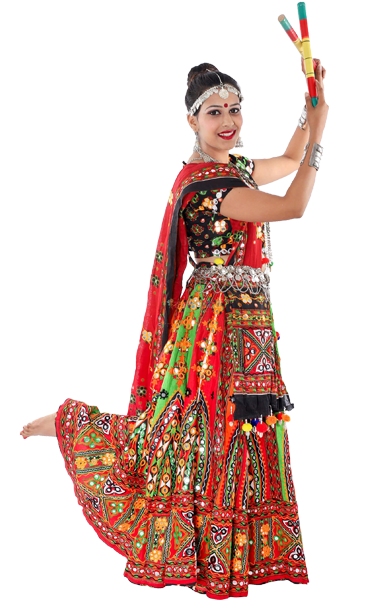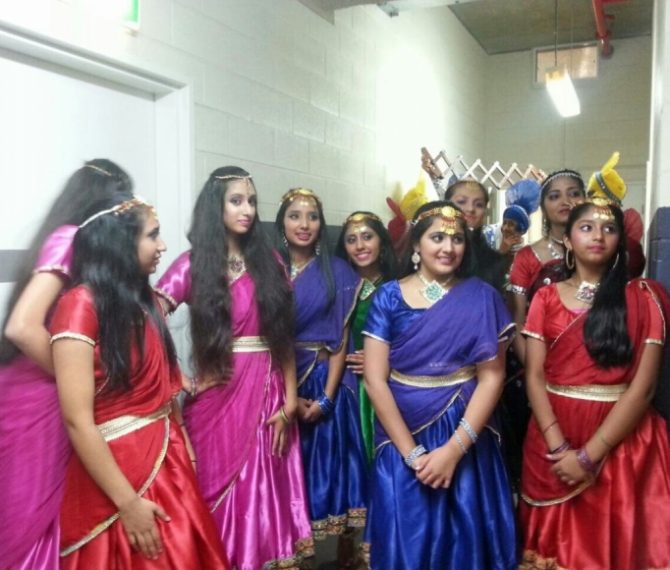Dance is an art, paint your dream and follow it.
India is a land of varied cultures and traditions. Diversities in all spheres make the Indian culture quite unique. Indian folk and tribal dances are product of different socio-economic set up and traditions. Indian folk and tribal dances are simple and are performed to express joy.

In India we have festivals and celebrations virtually every day. This has added to the richness of Indian culture. Since every festival is accompanied by celebration, folk dances have become an integral part of our social milieu. While there are numerous folk and tribal dances, they are constantly improved. The skill and the imagination of the dances influence the performance.
Folk dance has always been a part of Indian culture. India is a secular country and nothing best displays the secularism of this country than the various folk dances. Folk dance and Bollywood dance are the most sought after dance that is looked after and learned by people these days. There is diverse culture in this country and each of them has their special folk dance. The Elegant Creations teaches both folk dance and Bollywood dance. Here are few dances that we teach :
Punjabi
Punjabi Dance has its own value and importance. The way Punjabi dance is done, it portrays joy and happiness. Punjabi dance is unique in its own way and reminds us of the Punjabi culture.
(1) Bhangra (2) Luddi (3) Kikkli (4) Jhumar
Punjabi Dance has its own value and importance. The way Punjabi dance is done, it portrays joy and happiness. Punjabi dance is unique in its own way and reminds us of the Punjabi culture.
(1) Bhangra (2) Luddi (3) Kikkli (4) Jhumar
Gujarati
Garba is one of the traditional folk dances in Gujarat. This dance is a wonderful mix of music and culture. This dance is very common among people these days, and one of the best plays to display Garba skills is during Navratri.
Garba is one of the traditional folk dances in Gujarat. This dance is a wonderful mix of music and culture. This dance is very common among people these days, and one of the best plays to display Garba skills is during Navratri.
Rajasthani
The traditional folk dance of Rajasthan is Ghoomar. The dance involves circling along with the music and dancing with it. The entire dance is very easy to learn and follow.
The traditional folk dance of Rajasthan is Ghoomar. The dance involves circling along with the music and dancing with it. The entire dance is very easy to learn and follow.
Haryanvi
Haryana has many different types of folk dance among which Dhamal and Khoria is very famous. These dances are attractive and require the perfect co-ordination of movement of the body and music.
Haryana has many different types of folk dance among which Dhamal and Khoria is very famous. These dances are attractive and require the perfect co-ordination of movement of the body and music.
Central India
Gaur dance is a popular folk dance of Madhya Pradesh dances. Gaur dance is popular in the Sing Marias or Tallaguda Marias of South Bastar. Men put head-dresses with stringed 'cowries' and plumes of peacock feathers and make their way to the dancing ground. Women ornamented with brass fillets and bead necklaces with their tattooed bodies also join the gathering. The men beat the drums, tossing the horns and feathers of their head-gears to the rising tempo that gives the dance a wilder touch.
Gaur dance is a popular folk dance of Madhya Pradesh dances. Gaur dance is popular in the Sing Marias or Tallaguda Marias of South Bastar. Men put head-dresses with stringed 'cowries' and plumes of peacock feathers and make their way to the dancing ground. Women ornamented with brass fillets and bead necklaces with their tattooed bodies also join the gathering. The men beat the drums, tossing the horns and feathers of their head-gears to the rising tempo that gives the dance a wilder touch.
East India
Chhau is a popular folk dance of Bihar. Since masks form an important feature of this dance it is called 'Chhau', which means mask. All the Chhau performers hold swords and shields while performing. The stages are decorated and brightly lit by torches, lanterns and flickering oil lamps. The musical instruments used are the Dhol (a cylindrical drum), Nagara (a huge drum) and Shehnai (reed pipes). The Chhau dance is performed by men and boys. Chhau dance is full of energy and strength. It is interesting to note that the entire body of the dancer is engaged as a single unit. This body language of the dancer has to be poetic and powerful.
Chhau is a popular folk dance of Bihar. Since masks form an important feature of this dance it is called 'Chhau', which means mask. All the Chhau performers hold swords and shields while performing. The stages are decorated and brightly lit by torches, lanterns and flickering oil lamps. The musical instruments used are the Dhol (a cylindrical drum), Nagara (a huge drum) and Shehnai (reed pipes). The Chhau dance is performed by men and boys. Chhau dance is full of energy and strength. It is interesting to note that the entire body of the dancer is engaged as a single unit. This body language of the dancer has to be poetic and powerful.
North India
Dumhal is a popular dance of Kashmir. This dance is performed with long colorful robes, tall conical caps (studded with beads and shells). Dumhal dance is accompanied by songs which the performers themselves sing. It is supported by drums. There is an interesting tradition associated with Dumhal dance where the performers of this dance place a banner into the ground at a fixed location and they begin to men dance around this banner.
Dumhal is a popular dance of Kashmir. This dance is performed with long colorful robes, tall conical caps (studded with beads and shells). Dumhal dance is accompanied by songs which the performers themselves sing. It is supported by drums. There is an interesting tradition associated with Dumhal dance where the performers of this dance place a banner into the ground at a fixed location and they begin to men dance around this banner.
South India
Padayani is one of the most colorful and popular dances of Southern Kerala. Padayani is associated with the festival of certain temples, called Padayani or Paddeni. Such temples are in Alleppey, Quilon, Pathanamthitta and Kottayam districts. The main Kolams (huge masks) displayed in Padayani are Bhairavi (Kali), Kalan (god of death), Yakshi (fairy) and Pakshi (bird).
Padayani is one of the most colorful and popular dances of Southern Kerala. Padayani is associated with the festival of certain temples, called Padayani or Paddeni. Such temples are in Alleppey, Quilon, Pathanamthitta and Kottayam districts. The main Kolams (huge masks) displayed in Padayani are Bhairavi (Kali), Kalan (god of death), Yakshi (fairy) and Pakshi (bird).
West India
Dandiya is a popular folk dance of Rajasthan. Dressed in colorful costumes the performers play skillfully with big sticks in their hands. Dandiya dance is accompanied by the musical instrument called the 'Meddale' played by the drummer in the centre. The Bhil tribal of Rajasthan perform a variety of dances. All these folk dances correspond to the agricultural cycle. The Ghumer dance, Raika and Jhoria are some examples of this type of dance. The Gher dance is a favorite and popular dance of the Mina tribe who are similar to the Bhils while Valar is typical dance of the Garasias of Rajasthan.
Dandiya is a popular folk dance of Rajasthan. Dressed in colorful costumes the performers play skillfully with big sticks in their hands. Dandiya dance is accompanied by the musical instrument called the 'Meddale' played by the drummer in the centre. The Bhil tribal of Rajasthan perform a variety of dances. All these folk dances correspond to the agricultural cycle. The Ghumer dance, Raika and Jhoria are some examples of this type of dance. The Gher dance is a favorite and popular dance of the Mina tribe who are similar to the Bhils while Valar is typical dance of the Garasias of Rajasthan.
Class Schedule :
Adult Class Every Thursday - 6 PM
Children Class Every Thursday - 5 PM





